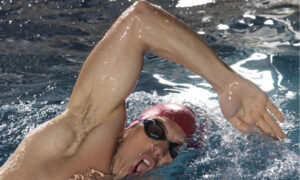Swimming for Pitchers?
Last week, I had three separate pitchers ask me what I thought about swimming between starts. My answer was pretty straightforward: I am not a fan at all.

There are several reasons for my contention with this as a useful modality.
Like pitchers, swimmers have some of the most dysfunctional shoulders in the entire sporting world; they have glaring scapular instability, big internal rotation deficits, and insufficient dynamic stability.
Sound familiar? These are the exact same things we work to address too keep our pitchers healthy.
For me, cross-training is about getting athletes out of pattern overload – not finding a similar means of reinforcing imbalances. Telling a pitcher to go swim is like encouraging a distance runner with a bum Achilles tendon to go jump rope instead. It’s an epic fail waiting to happen.

When it really comes down to it, I’d rather have guys actually throwing if they are going to develop imbalances. Pattern overload might as well give you improved motor control and technical precision if it’s going to increase your susceptibility to injury!
Speaking of specificity, the energy systems demands of swimming (longer distances, usually) don’t reflect what we see in pitching (short bursts of intense exertion). So, the arguments are in many ways similar to my contention with distance running for pitchers.
And, more anecdotally, while incredible athletes in the pool, most of the swimmers I have encountered have been far less than athletic on solid ground, presumably because the majority of their training takes place in the water, where stability demands are markedly different. I’d much rather see supplemental baseball training take place with closed-chain motion on solid ground – just like it does in pitching.
Finally, I’d like to see pitchers lift more – because they simply don’t do enough of it during the season. With limited time between outings, it’s important to get in the most important stuff first – and I just don’t see swimming as “important” when compared to flexibility training, soft tissue work, the throwing program, and strength training.
I’m sticking to my guns here. I’d much rather see pitchers doing what I outlined HERE between starts, as it keeps them strong, gets them moving in ways that don’t further ingrain imbalances, and avoids conflicting with the metabolic demands on pitching.
Sign-up Today for our FREE Baseball Newsletter and Receive a Copy of the Exact Stretches used by Cressey Performance Pitchers after they Throw!


